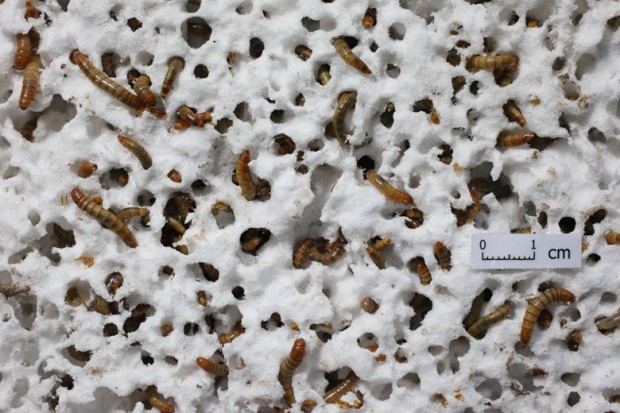Fifty years — that’s about how long it takes a plastic foam cup to decompose naturally in the environment.
New research though suggests that a tiny animal could do the work much faster, providing the first evidence that bacteria inside mealworm guts can degrade plastic materials.
The researchers at Stanford University and Beihang University in China believe this information could lead to new methods for dealing with plastic waste.
“Our findings have opened a new door to solve the global plastic pollution problem,” Wei-Min Wu, a senior research engineer at Stanford and study co-author, said in a statement.
The research published this week in the journal Environmental Science and Technology as a pair of studies (here and here) found that 100 mealworms ate up to 39 milligrams of Styrofoam each day, and within 24 hours excreted what they didn’t use into what the news release described as “biodegraded fragments that look similar to tiny rabbit droppings.” This excrement, Wu said, appeared to be safe in the soil for crops.
The researchers also found that the mealworms living on a diet of only the plastic for a month seemed just as healthy as the control group being fed a normal diet of bran.
Though previous research found that polyethylene was degradable by different types of worms and larvae thanks to bacteria in their gut, polystyrene — which is what Styrofoam is made out of — was not considered to be degradable in this way until now.
“Sometimes, science surprises us. This is a shock,” Craig Criddle, a civil and environmental engineering professor who led the research team on this study, said in a statement.
Going forward, the Stanford researchers and collaborators in China plan to study if mealworms and other insects can degrade other types of plastics like polypropylene and those tiny microbeads in some exfoliators that have been labeled as bad for aquatic environments. The researchers will also evaluate what happens to the products eaten by these animals when they are then eaten by other animals.
Further research will also include evaluating the enzymes the bacteria use in the guts of these creatures to break down the plastics, which could then someday translate into a commercial application for plastic waste management.
Because plastic waste is a problem in ocean environments as well, the scientists think further research areas include seeing if there is a marine equivalent capable of eating plastics similar to the mealworm.
